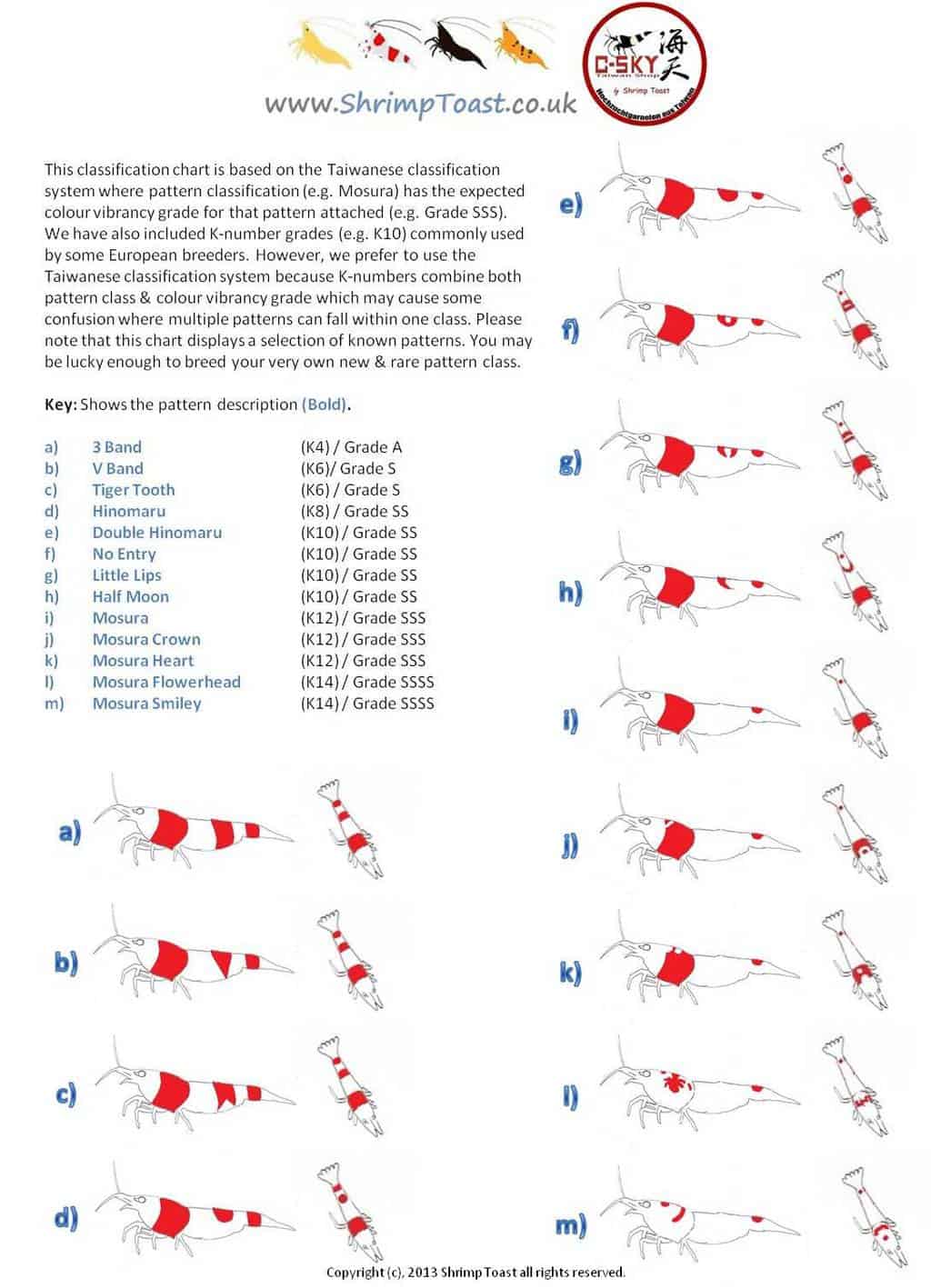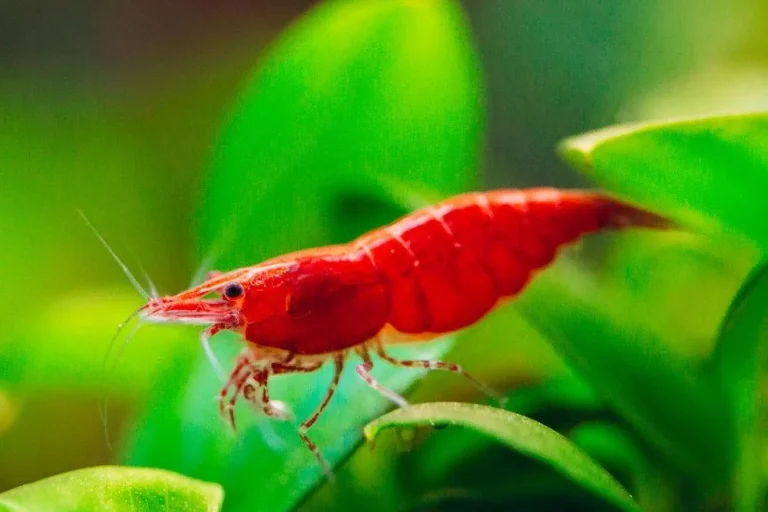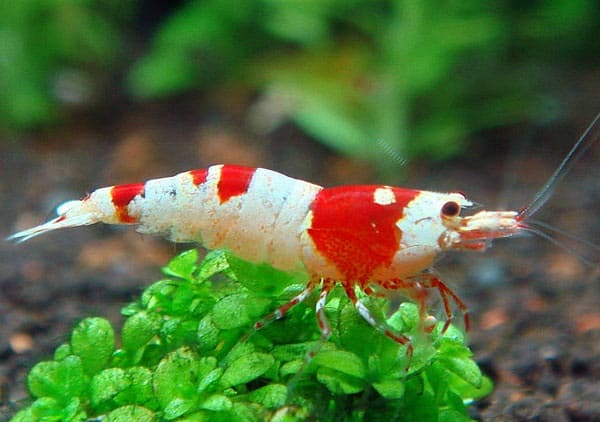Crystal red shrimps (CRS) are the latest buzz in the world of the freshwater aquarium hobby. It is capturing everyone’s heart with its beautiful and lovely red and white color pattern. Moreover, this active member of the Bee shrimp family is comfortable to take care of in the tank environment.
Naturally, beginners love starting their aquarium life with the red crystal shrimp. But when it comes to choosing the CRS for your tank, the crystal red shrimp grading can be a real challenge for you.
You will be most likely to get confused with the terminologies, and questions like why one type of CRS is cheap while the other has a leap in the price. Also, how is the grading done? Grading red cherry shrimp was easy if you ask my opinion!
To get the answer to all these invaluable questions regarding crystal red cherry shrimp grading with relation to its coloration and patterns, read on the article.
The Basics of Grading Crystal Red Shrimp
There are two grading systems for the crystal red shrimps. These are:
- The international grading (C-SSS)
- The German grading system (K0-14)

Although the grading is named differently, the classification mechanism for both systems works almost similarly.
As of the general rule, the higher the opacity level and presence of white, the higher the grade will be for CRS. Eventually, the price is higher too.
The grading is based upon three factors –
The whiter, the better: The amount of white mixed with the red or black coloration in the crystal red cherry shrimp determines its grading. Higher grade CRS has a more white color presence in it. However, an entirely white CRS is still regarded as one of the most top grades but not the best.
Opacity: Crystal red shrimp with more opacity is graded higher. The shrimps with a few patches of color spots, aka, transparency are ranked lower.
Older shrimps losing color: When an RCS reaches maturity and ultimately gets old, it is likely to lose its color intensity. Thus, it will be graded much lower.
Also, the intensity of red or black in the shrimp body plays a part in its grading.
Pattern Grading Vs. Color Grading
When it comes to crystal red shrimp grading, you will get to see two distinctive ways. These are-
Pattern grading: It is measured with the presence of white color in the proportion of red or black. It signifies two things, the amount of white vs. red or the amount of white vs. black.
Color grading: The color grade refers to the presence of transparency on the crystal red shrimp body. Ideally, the higher the clarity is, the lower the grading of the CRS. On the contrary, more opaque CRS enjoys more top and steep grades.
International Vs. German Grading Order
The lowest grade is C (mostly red or black with the least white). The highest grade is SSS+ (mostly whitish with the least black or red). The grading scale is from SSS+, SSS, SS+, SS, S, A, B, and C ordered from the greatest to the lowest.
On the contrary, the German grading is popularly known as K-class classification. The Longemann Brothers in Germany initiated the grading. It has a ranking that ranges from K-0 to K-14. The K-0 has the least white proportion, while the K-14 has the highest white percentage.
The Crystal Red Shrimp Color Grading
Now let’s dive prominently deep into the world of crystal red shrimp grades. We will, at first, see the color grades of the CRS.
C-grade (K-0):
We kick off our classification of crystal red shrimp with the lowest grade. Internationally, it is known as C-grade, and in German standard aquarists named it K-0. It is actually pretty close to the original crystal red shrimp.
It has a red body with some occasional white spots on the body. Also, it has the least opaqueness and currently not so popular among shrimp hobbyists.
Characteristics:
- Semi-transparent tail and rostrum.
- The abdominal section has a few thin white stripes. Otherwise, the lines are transparent and colorless.
- A few uneven spots of red in the body.
B-Grade (K—2):
This is, as you can guess, the second-lowest grading of crystal red shrimp. It has a few more patches of white color compared to the C-grade. Also, it has a little opaqueness too.
However, the coloration is still blotchy and unattractive. This is the first classification, where you can observe the actual color bands. Nonetheless, the color band presentation is far from the good, let along perfect.
Characteristics:
- The rostrum and tail have a slight presence of red color. However, it is dull red, not the intense one.
- It has some in distinctive white stripes in the abdominal part. The strips are skinny.
- It has a mostly transparent body with a few poorly painted white stripes.
- It has no visible or distinguishable white color bands.
A-Grade (K—4):
The A-grade CRS has a few more defined white bands and slightly more opacity too. It is a perfect CRS grading for the beginners to start their aquarium hobby. Also, the cheaper price tag makes it ideal for enhancing your CRS skill.
Characteristics:
- The tail and rostrum are a bit reddish.
- In A-grade CRS, the red color will still prevail over the white color.
- The red color is transparent and blotchy.
- It has relatively distinctive red stripes in the abdominal section.
- The white color band is solid. But it lacks intensity.
- You can find some distinguishable red and white stripes on the abdominal sections.
S-Grade (K-6):
It has a higher opacity. The body is more whitish and has a less-defined red color band. Moreover, the color presentation is solid and less transparent.
Characteristics:
- The carapace and rostrum are slightly red.
- The sides of the CRS body also have prominent red coloration.
- The abdominal part is whitish with higher opaqueness.
- The substantial white stripes are clearly visible.
- The white and red coloration is evenly distributed.
S+ Grade (K-6):
The S+ CRS grade is almost similar to that of S-Grade. Henceforth, in German grading, it is also the same K-6 classification. The color representation is more substantial compared to the S-grading.
Characteristics:
- The tail and rostrum are almost entirely white with a few red patches.
- At this point, white dots start appearing on the red carapace.
- The abdominal section has more intense, vivid, and opaque white stripes.
- S-plus grade has more white coloration compared to red colors.
SS-Grade (K-8 to K-10):
It is a higher classified red crystal with deep white coloration and slightly less red color. The SS-grade has a red dot line shape instead of the usual color bands. It is known as Hinomaru (we will discuss it in the pattern grading section).
Characteristics:
- In the majority of cases, the rostrum and tail section is entirely white. Occasionally, a few patches of red color can be visible.
- There are noticeable white dots with high-intensity on the red carapace.
- The majority of the abdominal section is white with opacity.
- In some cases, the top abdominal part may still carry a few red patches.
SSS Grade (K-14):
It is the highest color grade of red crystal shrimp. Ass you might guess, it has the highest amount of white coloration with the least redness. There’s also a supreme variant of the class that aquarium hobbyists refer to SSS Plus grade.
The exact grading between SSS and SSS+ depends on the patterns and coloration.
Characteristics:
- The body almost has a 75% white color presentation.
- The white color on the abdominal, rostrum, and tail section is rich and vivid.
- The carapace has prominent and easily visible white patches.
- In rare cases, there will be some red dots on the abdomen.
The Pattern Grading of Red Crystal Shrimp
I have already mentioned that the grading of red crystal shrimp is not only defined by the coloration only. Instead, it has a broader classification when it comes to patterns.

Let’s see more of the pattern grading.
Mosura (SSS) Grade:
It is the highest graded rating for CRS concerning color patterns. There are four distinctive classifications in the Mosura grade. These are
Mosura Flower: The sides of the red carapace have a flower-like white spot. It is clearly visible when you look sideward to the shrimp.
Mosura Heart: You can observe a heart-shaped dash on the top of the red carapace. It is visible from both sides.
Mosura Crown: As you might guess, the carapace has a whitish crown shape on the red shell. The crown is a bit semi-circle shaped, and it can be located either on the side or above the head. There will also be two massive rhombuses. These are red marked. The two rhombuses are linked with a line to the top rhombus on the head.
Smiley face: The CRS head has a red presentation with a dash on it. The rest of the body has a white band. The combo of the reddish head and the white shape resembles a smiley face from where it gets the name. At the 2015 Australian Shrimp Championship, it won the prize of Best Show.
SS (Hinomaru) Grade:
Hinomaru is a Japanese word referring to a red circle, much shaped like a moon. It has six variants depending on the intensity and position of the red circle.
The Rising Sun: The rising sun Hinomaru grade has an intense red carapace. The red shell is evenly interrupted with white bands that resemble a ruing sun. The red band is slowly reduced to a regular dot presentation in the K-8 CRS.
No-entry Hinomaru: Through the Hinomaru or red circle, you will see the passing of white dashes. It resembles the ‘no-entry’ sign. On the other side, the tail can be anywhere between red, white, or both. You will see it in the K-8 class.
Half-moon: While the carapace is still red and has white color bands, the abdominal section is much like a half-moon. It means the red dots are arranged in a semi-circle shape. It is found in K-10 grading.
Little Lips: The red band on the abdominal section is evenly divided by a thin white line. The red dots form a lip shape on either side, and it is prominent in the K-10 crystal red shrimp class.
Japanese flag: As the name suggests, the abdominal section is whitish, and on it, the red dots are arranged in a circle shape. So, it looks like a Japanese flag.
Large-Maro: You can see two prominent white dots right underneath the head and on the carapace. The white dots look like eyes, and some aquarists refer it to ‘Godzilla’ class.
S-Grade:
S-grade pattern variation is similar to the K-6 German classification. Two prominent identification signs upgrade a red crystal shrimp from the lower S-grade to the higher S+ grade.
Three white bands: As you get from the name, the CRS body has three white color bands that are easily visible. Besides, the class also has two prominent red groups. The tail is mostly red with a semi-red presence rarely.
Four white bands: The shrimp body carries three red and four prominent white groups.
Small Maro: Likewise, the large Maro grading, it also has two white dots on the carapace. The dots are minor and positioned behind the head.
V-band: The middle part is much like a triangle with a hint of whiteness on the red carapace. The red color ardently is a bit dull and lacks any red dash as well.
Tiger Tooth: In the middle of the red carapace, you will find a whitish triangular shape. It is placed at the hinge part of the shell. It resembles a tooth shape and hence the name.
Color or Pattern Grading: Which is preferable?
Now that you have a prominent and clear idea about the crystal red shrimp grading depending on both patterns and colors ardently. And you also have seen that some high-grade patterns are falling behind when it comes to color grading.
So, which one should you prefer?
Well, the color grading is preferable and applaud by the shrimp hobbyists.
Suppose you get a smiley face SSS+ CRS, and the chances are high that it may cost you up to $100. But if its body is transparent, its price will fall as low as $10. So, here’s the big decision, check the opaqueness and color variance (presence of white) more than the pattern appearance for the CRS grading.
Where To Buy CRS
As you can understand the higher is the grade the steeper is the price tag. But the challenge doesn’t stop there. It is really hard to find a reliable source for the higher grades. Only a handful of hobbyists are successful to breed the rarest variant of the CRS. Other than that I prefer the below two online market places to buy crystal shrimps –
Wrapping Up
So, finally, we are at the end of the guideline on grading crystal cherry shrimp. And you might have guessed; it is an extremely challenging and confusing task to remember all the classification of CRS even for an expert.
The grading is based on the appearance, and through selective breeding, you can actually achieve the desired CRS grade. Nonetheless, some categories such as SSS+ or Smiley Face and Tiger Tooth are extremely rare and not available in the regular market.
So, tell me, which CRS grade is your favorite?






